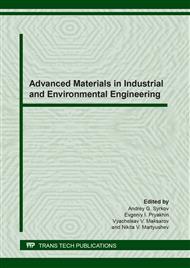[1]
J. Liang, Z. Deng, X. Jiang, F. Li, Y. Li, Photoluminescence of tetragonal ZrO2 nanoparticles synthesized by microwave irradiation, Inorg. Chem. 41 (2002) 3602-3604.
DOI: 10.1021/ic025532q
Google Scholar
[2]
S. C. Thomas, Harshita, P. K. Mishra, S. Talegaonkar, Ceramic nanoparticles: Fabrication methods and applications in drug delivery, Curr. Pharmaceutical Design 21 (2015) 6165-6188.
DOI: 10.2174/1381612821666151027153246
Google Scholar
[3]
J. B. Fathima, A. Pugazhendhi, R. Venis, Synthesis and characterization of ZrO2 nanoparticles-antimicrobial activity and their prospective role in dental care, Microbial Pathogenesis 110 (2017) 245-251.
DOI: 10.1016/j.micpath.2017.06.039
Google Scholar
[4]
S. Sagadevan, J. Podder, I. Das, Hydrothermal synthesis of zirconium oxide nanoparticles and its characterization, Journal of Mat. Sci.: Materials in Electronics 27 (2016) 5622-5627.
DOI: 10.1007/s10854-016-4469-6
Google Scholar
[5]
T. Kozawa, J. J. Santillan, T. Itani, Electron-hole pairs generated in ZrO2 nanoparticle resist upon exposure to extreme ultraviolet radiation, Japanese Journal of Applied Physics 57 (2018) 026501.
DOI: 10.7567/jjap.57.026501
Google Scholar
[6]
I. R. Gibson, G. P. Dransfield, J. T. S. Irvine, Sinterability of commercial 8 mol% yttria-stabilized zirconia powders and the effect of sintered density on the ionic conductivity, J. Mat. Sci. 33 (1998) 4297-4305.
DOI: 10.1023/a:1004435504482
Google Scholar
[7]
Y. H. Lee, C. W. Kuo, I. M. Hung, K. Z. Fung, M. Wang, The thermal behavior of 8 mol% yttria-stabilized zirconia nanocrystallites prepared by a sol–gel process, J. Non-Cryst. Solids 351 (2005) 3709-3715.
DOI: 10.1016/j.jnoncrysol.2005.09.029
Google Scholar
[8]
B. L. Kirsch, S. H. Tolbert, Stabilization of isolated hydrous amorphous and tetragonal zirconia nanoparticles through the formation of a passivating alumina shell, Adv. Funct. Mater. 13 (2003) 281-288.
DOI: 10.1002/adfm.200304267
Google Scholar
[9]
S. N. Basahel, T. T. Ali, M. Mokhtar, K. Narasimharao, Influence of crystal structure of nanosized ZrO2 on photocatalytic degradation of methyl orange, Nanoscale Research Letters 10 (2015) 13.
DOI: 10.1186/s11671-015-0780-z
Google Scholar
[10]
J. Azorin, T. Rivera, C. Furetta, A. Sánchez-Rodríguez, Ultraviolet induced thermoluminescence in gadolinium-doped zirconium oxide films, Materials Science Forum 480-481 (2005) 145-148.
DOI: 10.4028/www.scientific.net/msf.480-481.145
Google Scholar
[11]
A. Khataee, P. Gholami, B. Kayan, D. Kalderis, L. Dinpazhoh, S. Akay, Synthesis of ZrO2 nanoparticles on pumice and tuff for sonocatalytic degradation of rifampin, Ultrasonics Sonochemistry 48 (2018) 349-361.
DOI: 10.1016/j.ultsonch.2018.05.008
Google Scholar
[12]
T. Akune, Y. Morita, S. Shirakawa, K. Katagiri, K. Inumaru, ZrO2 Nanocrystals as catalyst for synthesis of dimethylcarbonate from methanol and carbon dioxide: Catalytic activity and elucidation of active sites, Langmuir 34 (2018) 23-29.
DOI: 10.1021/acs.langmuir.7b01294
Google Scholar
[13]
I. V. Karpov, A. V. Ushakov, A. A. Lepeshev, L. Yu. Fedorov, Plasma-chemical reactor based on a low-pressure pulsed arc discharge for synthesis of nanopowders, Technical Physics 62 (2017) 168-173.
DOI: 10.1134/s106378421701011x
Google Scholar
[14]
A. A. Lepeshev, I. V. Karpov, A. V. Ushakov, G. E. Nagibin, The morphological and structural features of ferrite compositions (1–x)MeFe2O4·xP2O5 prepared by plasma spraying, J. of Alloys and Compounds 663 (2016) 631-635.
DOI: 10.1016/j.jallcom.2015.12.168
Google Scholar
[15]
A. A. Lepeshev, O. A. Bayukov, E. A. Rozhkova, I. V. Karpov, A. V. Ushakov, L. Yu. Fedorov, Modification of the phase composition and structure of the quasicrystalline Al-Cu-Fe alloy prepared by plasma spraying, Phys. of the Solid State 57 (2015) 255-259.
DOI: 10.1134/s1063783415020249
Google Scholar


